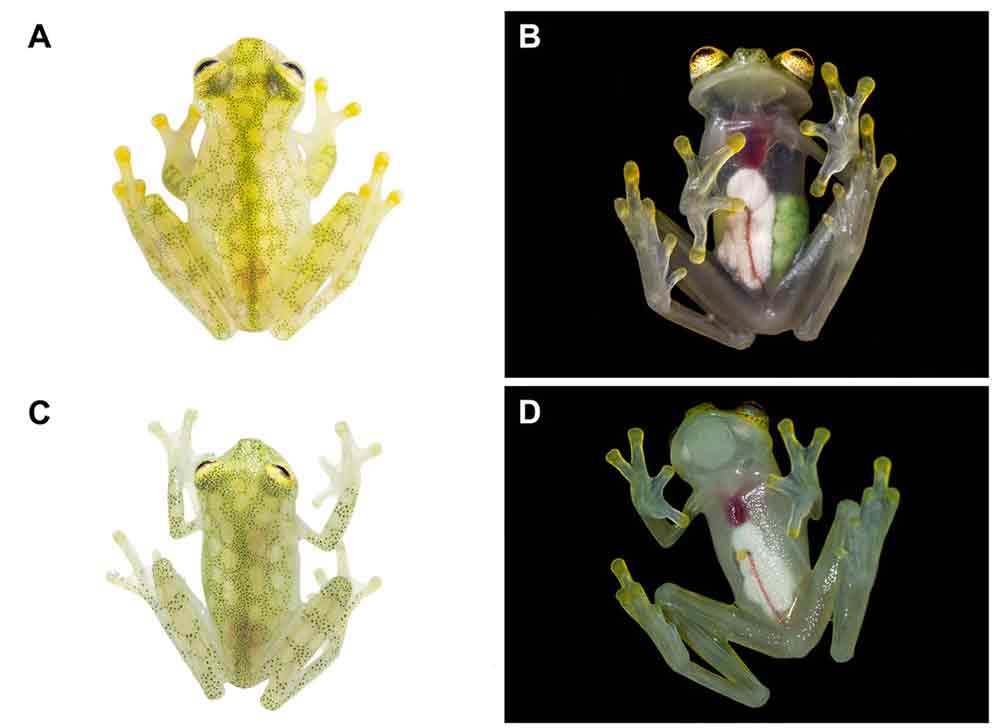Both frogs are a translucent green in coloration with yellow spots and see through bellies.
Researchers in Ecuador have discovered two new glass frog species of the family Centrolenidae, genus Hyalinobatrachium in the Ecuadorian Andes, the world’s biodiversity hotspot with more than 1000 described amphibian species.
The Mashpi glassfrog (Hyalinobatrachium mashpi) was discovered in Ecuador’s Pichincha province in the Mashpin river basin. It is also known to inhabit the Amagusa Reserve (Amagusa River, 1,137 meters; Mashpi Chico River, 1,130 meters); and the Tayra Reserve, 976–1,126 meters, according to the paper, “Two new glassfrogs (Centrolenidae: Hyalinobatrachium) from Ecuador, with comments on the endangered biodiversity of the Andes” published March 18 in the journal Zoological Science.

(A) Hyalinobatrachium mashpi sp. nov., CJ11642 (holotype). (B) H. nouns sp. nov., ZSFQ0537. (C) H. aureoguttatum, SC 435. (D) H. talamancae, Costa Rica. Photos by Jaime Culebras (A, D, E, F), Jose Vieira (B) and Luis Coloma (C).
The second frog, the Nouns’glassfrog (Hyalinobatrachium nouns) (Spanish name Rana de Cristal de Nouns) is known to inhabit the Río Manduriacu Reserve and Bosque Protector Los Cedros at elevations from 1,177-1,420 meters (3,862-4,659 feet) above sea level.
Both species separated by Intag-Guayllabamba river valley
According to the researchers, the reserves are next to each other within the Toisán Mountain Range, Imbabura Province in Ecuador. These reserves are premontane wet tropical rainforests and cloud forests and situated in an area where illegal deforestation and mining occurs.

Parental care in Hyalinobatrachium mashpi sp. nov.
(A) Male calling at San Vicente River, Mashpi Reserve, Pichincha Province, Ecuador. (B) Male at tributary of the Mashpi River, Tayra Reserve, Pichincha Province, Ecuador. Photos by Carlos Morochz (A) and Jaime Culebras (B).
Both frogs are a translucent green in coloration with yellow spots and see through bellies. Hyalinobatrachium mashpi sp. nov seems to look less green in coloration with darker yellow spots, while H. nouns sp. nov. sports a darker green with more muted yellow spots. Hyalinobatrachium mashpi also seems to have darker yellow toes.

Dorsal patterns of glassfrogs in life.
(A) Hyalinobatrachium mashpi sp. nov., CJ11642 (holotype). (B) H. nouns sp. nov., ZSFQ0537. (C) H. aureoguttatum, SC 435. (D) H. talamancae, Costa Rica. (E) H. vireovittatum, Costa Rica. (F) H. valerioi, Costa Rica.Photos by Jaime Culebras (A, D, E, F), Jose Vieira (B) and Luis Coloma (C).
Locality
The researchers say the frogs are very close geographically at 18.9 km, but are separated by the Intag-Guayllabamba river valley. They recommend that both species be listed as Endangered following IUCN Red List criteria. Main threats to both species include contamination due to cattle ranching, agriculture, habitat loss, and mining activities.
Four New Species Of See-Through Glass Frogs Discovered In Peru
Glass Frog Care And Information
The complete paper, Two new glassfrogs (Centrolenidae: Hyalinobatrachium) from Ecuador, with comments on the endangered biodiversity of the Andes can be read on the PeerJ website.


